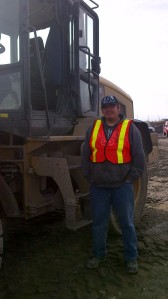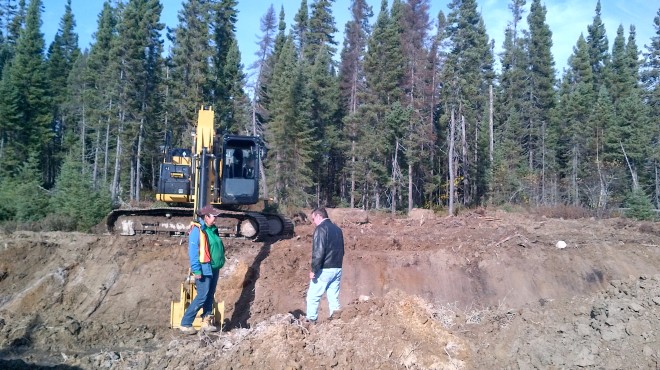
Heavy Machine Operator
Here is a recent article on Heavy Equipment Operation in the North to be published soon. I spent the day on various construction sites. I wish I had worn my billy boots instead of sneakers!
It was still dark at 6:00 a.m. when Paul Paquette parked his white pickup truck in front of the Tim Hortons located at the Cree Nation of Mistissini. He did a quick headcount. All seven of his students were there, finishing breakfast or lining up for a coffee to go. This is where Paquette, instructor of the Northern Heavy Equipment Operations program, meets with his students from Monday to Friday.
Absenteeism has never been a problem for Paquette. “My students are always here, ready to work, and willing to do overtime when they’ve missed time. If they are late, they offer to do overtime even on weekends.”
The Northern Heavy Equipment Operations program, offered by the Sabtuan Adult Education Services of the Cree School Board, provides educational and training opportunities for adults living in Cree communities. At the completion of the program, graduates will obtain a diploma from the Ministère de l’Éducation du Québec. This will enable them to find work in the construction industry, mines, camps, or in the community. The popular program has a waiting list of 78 students and is considered one of the best employability programs.
The 900-hour-program takes place in a limited season and is dependent on weather conditions. Most learning occurs on-site.
When not outside, learning to operate heavy equipment, students are instructed in the basic principles of construction, road maintenance, maintenance of heavy equipment, as well as health and safety on construction sites. Theoretical learning constitutes 25% of the program
The week of October 7, 2013 students were working the morning shift, from 6:00 a.m. to noon. A parallel program runs from noon to 6:00, taught by Jacques Labelle. The weekly rotating schedule of the two courses maximizes the use of the heavy machinery.
Paquette spends most of his day driving from site to site to instruct and supervise his students, or just to offer encouragement and congratulations for a job well done.
Paquette’s first stop was at the home of Leonard Coon and Kimberley Shecapio-Coon, where a student, Nelson Trapper, operated a backhoe. Trapper’s job was to level the lot and remove stones in preparation for the laying down of topsoil and sod.
This type of on-the-job training benefits community and gives the students exposure.
At the inception of the program, on May 22, 2013, Paquette met the Cree School Board’s coordinator of vocational adult training, Luc Collette, to go over community work projects. Then Paquette chose those jobs which the students will benefit from most as part of the program.
Paquette’s team of students have worked on 18 different jobs since the beginning of the course.
At Trapper’s worksite, Paquette observed as his student stepped out of the backhoe and squatted on the ground, gaging the angle of the slope with his eye, to ensure that water would drain away from the house.
“I like that!” Paquette exclaimed, giving Trapper a ‘thumbs up.’ “For this job, you need a good eye for landscaping.” Paquette is pleased when his students take charge of a project and show responsibility.
Homeowner Coon watched as Paquette and Nelson planted surveying sticks for the next step. There is some urgency, as sod is due to arrive the next day.
“We are very happy with the work,” Coon smiled.
Paquette’s students work a rotating daily schedule on assigned machines so that each student has the opportunity to work in different mediums with different machines.
At a nearby camp, Wayne Voyageur reshaped a camp road with a grader.
Working with heavy equipment is new to Voyageur. He heard about the course while working at the Mistissini Lodge. Not only is he learning to operate heavy equipment, but also the routine maintenance such as changing air filters, water separators, and lubricating.
Voyageur’s objective is to have a better career to support his family.
At another worksite, Marcel Gunner is operating a 6 x 6 articulator, an off-highway truck.
Gunner has experience working in construction and has, as have other students, taken jobs in the community.
At a recent job, students cleared land for Jerry Matoush, owner of the community’s tire shop. Paquette explained that 114 loads of rocks and slashed trees were excavated.
When compensation was offered to the students, they teamed together to purchase jackets with SAES crest embroidered on, along with their names.
After giving further directions to Gunner, Paquette made a detour to the dry goods dump just outside of town. Neatly piled discarded appliances were the only indication of garbage. Paquette explained that this is a perfect place for students to practice their operating skills by digging holes and filling them with waste, and then piling gravel on top.
Paquette pulled out his cell phone to call student, Matthew Bullfrog. Bullfrog was working the loader that day. Paquette instructed him to load up the truck with topsoil and bring it to Trapper, who would level it in preparation for the grass that would be arriving the next day.
Paquette turned onto a road leading to a gravel pit, where Betsy Rabbitskin was filling a loader with gas from a parked service vehicle for that purpose.
The gravel for community projects comes from this quarry and is dynamited as needed.
Rabbitskin acted as observer for the day, since only six machines are available for the seven students.
As a child, Rabbitskin recalled how she liked to play with dolls and things, but also liked to play with her brother’s cars and trucks.
“I like them all,” she replied when asked if she had a favourite machine. “I knew I always had it in me that one day I will operate these machines.”
Richard Cooper was operating a bulldozer when Paquette stopped by to see his progress. Cooper’s day doesn’t end at noon. After his school day is over, he goes to work, resulting in 12-hour workdays.
Like Gunner, Cooper works for other companies as an operator. Paquette explained that when students work for contractors, and get paid directly, it works towards their stage.
At another camp, Linda Loon was creating a system of drainage ditches to aid nearby camps from spring snowmelt runoff.
Loon climbed down from the excavator she was operating that day and came forward to greet Paquette.
“Paul, I am so proud of myself,” she said pointing at a large boulder. “I got that rock out.”
“Good job!” Paquette called to her, holding out his arms as in a giant embrace.
Linda had called Paquette earlier, when she was experiencing difficulties with a rock that was stuck.
“I was afraid to tip over, so I did it slowly,” she explained.
Just before departing, Paquette advised Loon to make holes about 10 paces apart along the side of the road and plant uprooted trees. This would make the road more visible in winter and provide definition. He then added, “It will look nice, too”.
Like Gunner and Cooper, Loon has done work for Cree communities. At one of her jobs, she worked at the dump at a nearby community of Oujé-Bougoumou.
Paquette stopped at Bullfrog’s worksite. As instructed by Paquette twenty minutes earlier by phone, Bullfrog was loading a truck with topsoil to bring to Trapper.
Bullfrog admitted he was worried, at the onset of the course, about operating the machines and performing the required maintenance.
“But now it’s almost second nature. I feel very comfortable with the machines now,” he said.
Bullfrog’s plan is to go outside the community to work 14 days on and 14 days off. On his days off, he hopes to contribute to the community.
After completing the requirements of the program and obtaining their diploma, the students will register at the Commission de la construction du Québec (“CCQ”) towards certification required to work in the construction industry. They will obtain an apprenticeship card so their hours are logged in.
The CCQ has set conditions for hiring labor to which construction companies must comply. Graduates must complete 2,000 hours through training and/or work experience.
Of the 900 hours students have completed as part of the Northern Heavy Equipment Operations program, 165 hours of the SAES program are recognized towards these 2,000 hours and the graduates must make up the rest on the job.
The end result is a certificate attesting to their competence, Le certificat de compétence-compagnon, allowing them to work in the construction industry.
In 1997, the CCQ put forth new regulations to promote women’s access to the construction industry, as well as their maintenance and to increase their numbers in this field.
Rabbitskin and Loon agree that they have not experienced any obstacles in working non-traditional roles as women.
“People see me driving on the road and they go like this,” Loon said, gesturing a thumb-up sign.
Loon’s fascination with big machines began when she saw a woman operating a machine similar to the excavator she was operating that day.
She was surprized at first. “But then I looked and watched, and thought ‘I’d love to do that -operate machines!’”
Rabbitskin also feels that the community is proud of ‘us women’.
“They think it’s awesome, cool being a woman driving these things,” she said.
Job prospects are numerous. The money may be good, working in mines and construction, but being away from the community, family, travel time to and from the work place and shift work can be definite drawbacks.
Some students, like Loon, would like to stay in the community to remain close to their families. By closer to home, they may be hired by the band counsel for snow removal, landscaping and regular maintenance.
Other students, such as Cooper and Gunner, realize that money is to be made working outside in mines or construction industry.
A Trade and the Training Process module was offered as part of the program to help students with their choices and job searches.
After finishing the program, Bullfrog hopes for find a job at a mine such as Diamond Mine Stornoway. “They’ve already offered jobs to students,” he said.
The students concur that Paquette is a dedicated teacher, who wants to help them succeed in every aspect of the program.
“Paul is a very good teacher,” Gunner said. “He’s interesting and I am learning a lot. He helps with everything. Only problem is that he’s a Habs fan,” he added.
Bullfrog admitted that he was first scared of the heavy equipment.
“Paul has showed me how to work with machines and I fell in love with them,” he said. “He’s funny and he uses analogues and makes things funny.”
On the way back to his original starting point at Tim Hortons, Paquette drove past the homeowner’s property where Trapper had been levelling the ground. Piles of topsoil had been unloaded by Bullfrog, ready to be prepared for tomorrow’s shipment of sod.
It was only noon and the student’s shift was over, but Paquette knew his seven students would be waiting for him tomorrow at 6:00 to start a new day.

Linda is happy to have removed a large boulder on her own.





